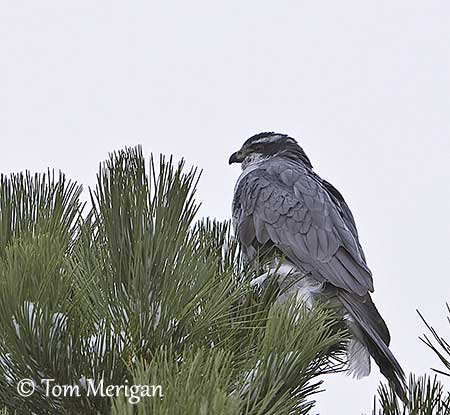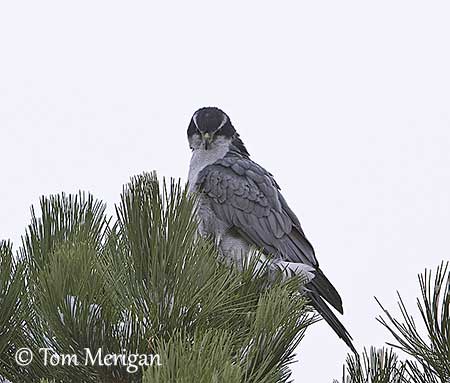
Fr: Autour des palombes
Ang: Northern Goshawk
All: Habicht
Esp: Azor Común
Ita: Astore comune
Nd: Havik
Sd: Duvhök
Photographers:
José Luis Beamonte
Pájaros de España
Ken Havard
My Bird Gallery & Flickr gallery 1 & Flickr gallery 2
Tom Merigan
Tom Merigan’s Photo Galleries
Otto Plantema
Trips around the world
Text by Nicole Bouglouan
Sources:
HANDBOOK OF THE BIRDS OF THE WORLD Vol 2 by Josep del Hoyo-Andrew Elliot-Jordi Sargatal - Lynx Edicions - ISBN: 8487334156
GUIDE DES RAPACES DIURNES – Europe, Afrique du Nord et Moyen-Orient de Benny Génsbol – Delachaux et Niestlé – ISBN : 2603013270
All About Birds (Cornell Lab of Ornithology)
Bird Web (Seattle Audubon Society)
Pájaros de España (JL Beamonte)
Global Raptor Information Network - Working to Conserve Birds of Prey in nature
What Bird-The ultimate Bird Guide (Mitchell Waite)
European Raptors – Biology and Conservation
Northern Goshawk
Accipiter gentilis
Accipitriformes Order – Accipitridae Family
INTRODUCTION:
The Northern Goshawk is included in the 6th group of the family Accipitridae. This species, and especially the female, is the largest raptor of the genus Accipiter.
It is an agile hunter. It may perform direct attack on a flying bird by fast coursing, high soaring flight, or glide and chase. The prey is caught and killed with the strong talons.
The Northern Goshawk is widespread throughout its wide range in both Eurasia and North America. It is fairly common in falconry, involving illegal nest robbing. But currently, the population appears stable in spite of several potential threats.

DESCRIPTION OF THE BIRD:
Biometrics:
Length: 46-63 cm
Wingspan: 89-122 cm
Weight race “gentilis”: M: 517-1110 g – F: 820-2200 g
Weight race “atricapillus”: M: 677-1010 g – F: 758-1210 g
The Northern Goshawk is a powerful raptor with short, rounded wings and long tail.
The adult has brownish-grey to slate-grey upperparts, whereas underparts are pale grey and strongly barred blackish on breast, underwing-coverts and thighs. The throat shows mostly vertical streaks, extending to the malar area. The undertail-coverts are white and fluffy. Flight feathers and rectrices are pale grey with conspicuous dark barring.
The head is black with distinctive white stripe narrowly streaked black from forehead to hindcrown.
The hooked bill is black with pale yellow cere. The eyes are yellowish-orange in female and orange-red in male. Legs and feet are yellow with black talons.
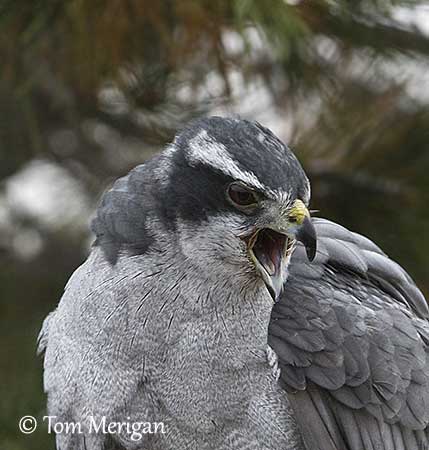
The female is larger and heavier than male. She has browner-grey upperparts.
The juvenile has brown upperparts and pale buff to whitish underparts streaked dark brown. On the head, the supercilium is less conspicuous, mostly pale buff and shorter than in adults.
The immature has yellow iris until its 4th year.
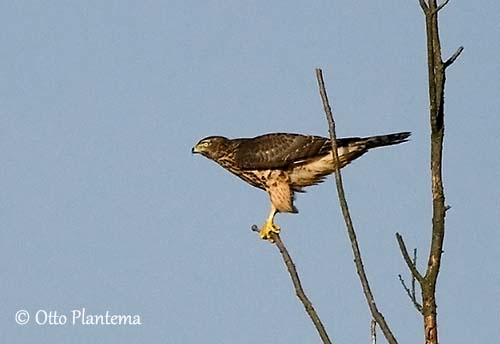
SUBSPECIES AND RANGE:
The Northern Goshawk has 10 recognized subspecies.
A.g. gentilis (described above) or Eurasian Goshawk is found in Europe (except NE and SE) and N Morocco.
A.g. buteoides occurs in extreme N Eurasia from N Sweden E to Lena River in Siberia. It winters S to C Europe and C Asia. This race is larger than nominate with similar plumage.
A.g. albidus is found in NE Siberia to Kamchatka. This one is very pale and may occur in two morphs, one nearly pure white and the other with pale grey upperparts and sparsely barred underparts.
A.g. schvedowi is found in S Urals E to NE China and Amurland. This race is smaller than nominate, and the underparts are narrowly and densely barred.
A.g. fujiyamae is found in Japan. This one is smaller than previous, with stronger barring on vent and often yellow eyes.
A.g. arrigonii occurs in Corsica and Sardinia.
A.g. marginatus is found in Italy and Balkans, E to Caucasus and N Iran.
A.g. atricapillus or American Goshawk is found in N America from Alaska E through C Canada to N Quebec, Labrador and Newfoundland, and S to SW USA and in E USA. This race has broad supercilium and deep red iris.
A.g. laingi occurs in Queen Charlotte Islands and Vancouver Island in W Canada. This one is darker and more heavily barred than the previous.
A.g. apache occurs in SW USA (Arizona and SW New Mexico) and W Mexico. This race is larger and darker than “atricapillus”.
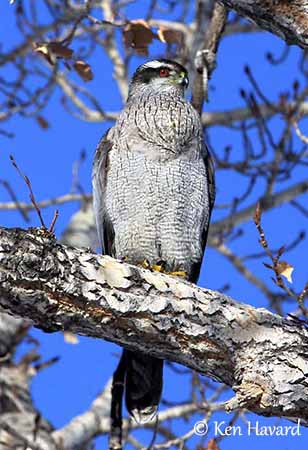
HABITAT:
The Northern Goshawk frequents mature woodlands, coniferous and deciduous or mixed forests, and it is mainly seen near the edges. It also occurs in lowlands and mountains, from sea-level up to 3000 metres of elevation in subalpine woodlands. It hunts mainly in clearings which provide it more preys.
CALLS ANS SONGS: SOUNDS BY XENO-CANTO
The Northern Goshawk is more vocal during the breeding season. The adults give rapid, repeated, loud “kik-kik-kik-kik-kik” as alarm call and contact call. These sounds are usually heard near the nest. Another call “eeeeh” similar to that of the Eurasian Buzzard, is used a contact between mates. While taking off, they give a short “tsjitt”.
The juveniles beg for food with high-pitched “whee-oo, whee-oo, whee-oo”.
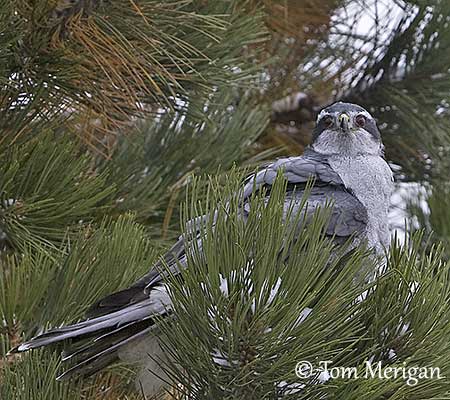
BEHAVIOUR IN THE WILD:
The Northern Goshawk feeds primarily on small and medium-sized birds, but it also takes hares and various other vertebrates, including lizards in C Spain. But the diet depends on region and season.
In the northern parts of the range, it feeds mainly on grouses and Corvidae. In other regions, pigeons, thrushes and starlings are among the usual preys. During the breeding season, it catches numerous chicks and fledglings of other bird species. Some mammals, including hares, rabbits, tree squirrels and rats are also taken on the wintering grounds in Finland.
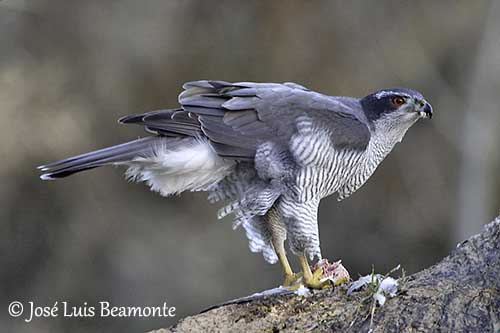
The Northern Goshawk hunts by flying low, but it is able to perform high speed flight over 500 metres before to catch the prey on the ground with the talons. It also hunts from hidden perches. It can be seen flying along the forest edge or in meadow, flying low to surprise the prey. It attacks with a short flight followed by great burst of speed, and often ends through branches while pursuing a prey.
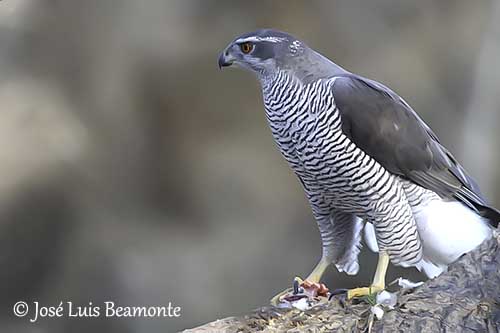
During the breeding season, the Northern Goshawk performs spectacular aerial displays over the nesting territory. The adults can be seen gliding and circling while their fluffy white undertail-coverts are spread out to the sides of the tail’s base. Series of shallow dives and upward flights are performed too, like “sky-dances” and undulating flights.
Both mates are monogamous with long-term pair-bonds. Prior to the laying, the male regularly feeds the female.
The Northern Goshawk is usually sedentary, although the northernmost birds of North America, Fennoscandia and Russia are partially migratory. In Arctic regions, they move according to prey availability. These movements are not extensive with only a few hundred kilometres. They leave the breeding grounds in October/November, and return in March/April.
The Northern Goshawk is a powerful flier. It generally soars on thermal currents, but during the migration, it often alternates wingbeats and glides.
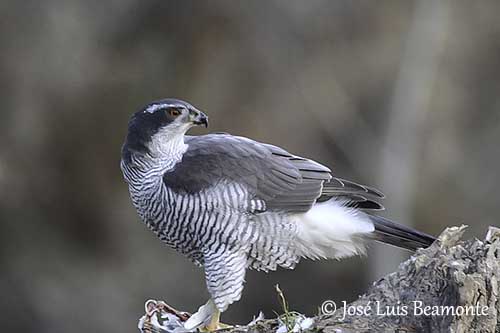
REPRODUCTION OF THIS SPECIES:
The nest-building begins at the start of courtship displays, and the female does most of the work. The nest is placed in a large tree, usually on horizontal branch, in a fork or close to the trunk. It is made with sticks, and there is a lining of bark chips in the cup of about 90 centimetres of diameter.
The Northern Goshawk pair usually maintains several nests within the territory, and uses them alternately, sometimes in following years. They nest solitary.
The female lays 3-4 eggs between early April and early June. The incubation lasts 35-38 days, mainly by female. At hatching, the downy chicks are brooded for several days (9-14) and later, the female broods them only at night until they are 24 days old. They fledge between 36 and 42 days after hatching. They are independent 4-8 weeks later. The young males fledge earlier than the young females. They are fed by both parents and while their plumage is growing, they learn how to hunt with the adults.
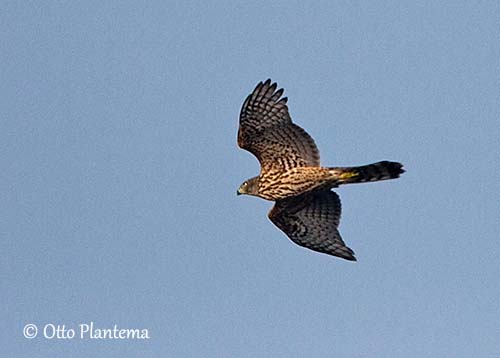
PROTECTION / THREATS / STATUS:
The Northern Goshawk was affected by important declines in Europe in the 19th and 20th centuries, due to persecution and deforestation. Later, other declines occurred with poisoning from pesticides and heavy metals.
This species is still threatened by persecution and nest robbing for falconry. The wind farms’ development is an important threat for them too.
However, the Northern Goshawk has wide range and its populations are now fairly stable. The global population was estimated at 500,000 individuals in 2004.
The Northern Goshawk is currently evaluated as Least Concern.
